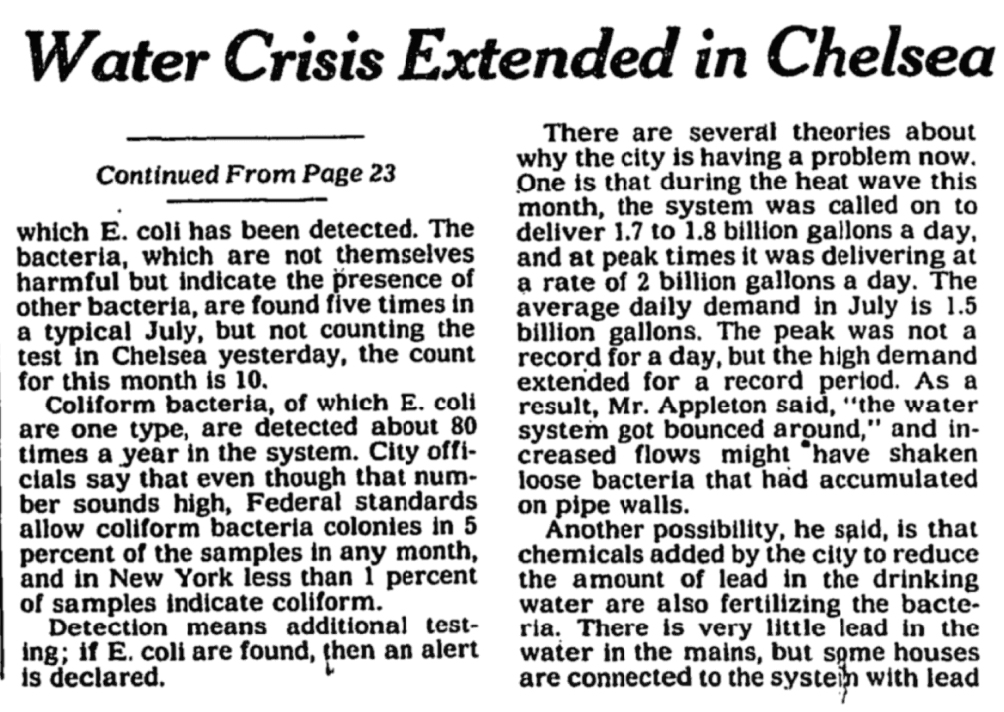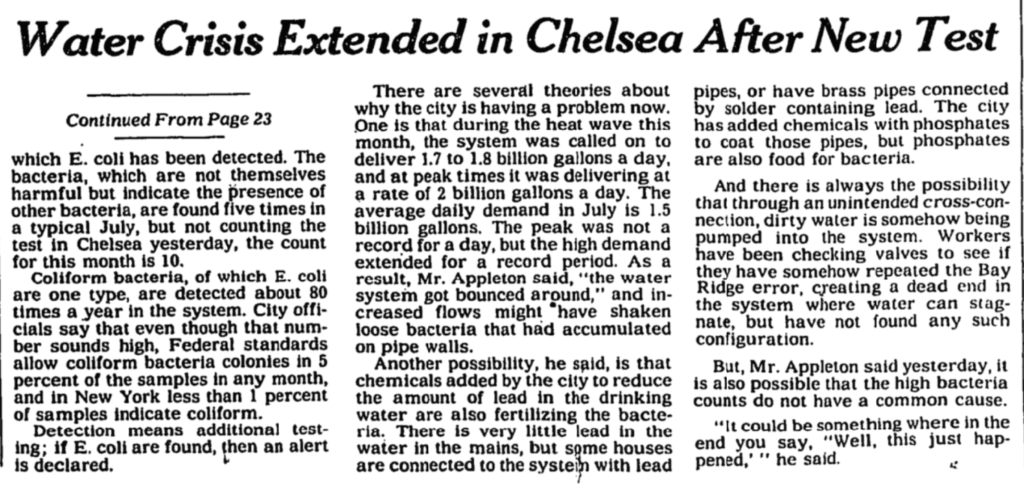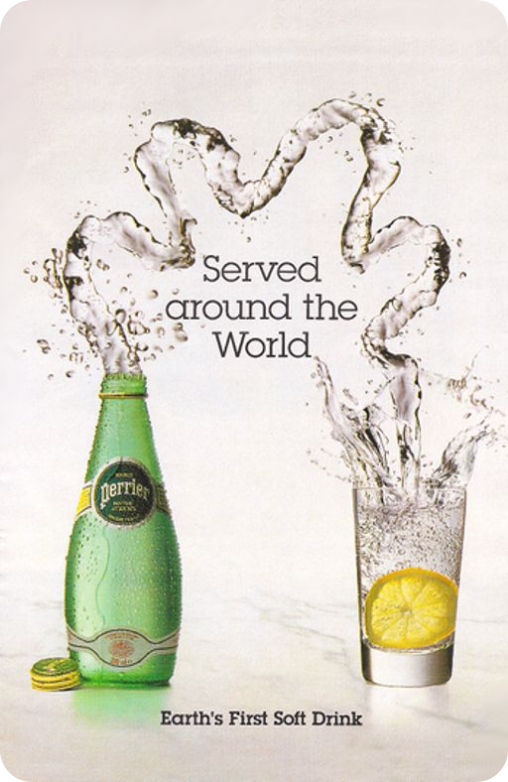Contamination and Bottled Water
The quality of New York City’s unfiltered water, specifically the Croton systems, came into question in the early 1990s. The pipes were aging, and the once sparsely populated region was becoming more developed. Particular concerns revolved around chloride levels, which had risen 265% since 1960, and the discovery of E. Coli in tap water from Chelsea and the Lower East Side (both of which were served by the Croton reservoir). In response, the city issued a boil water warning, and sales of bottled water spiked. Interestingly, however, bottled water sales had been increasing in New York even before these health alerts. Bottled water consumption grew rapidly due not only to increased anxiety over water quality, but also to the successful marketing of mineral waters as a healthy choice, particularly for wealthier residents who were the main buyers of bottled water in New York City.

Chloride in Drinking Water
Chloride in surface and groundwater comes from both natural and anthropogenic sources, such as run-off containing road de-icing salts, the use of inorganic fertilizers, landfill leachates, septic tank effluents, animal feeds, industrial effluents, irrigation drainage, and seawater intrusion in coastal areas. Chloride increases the electrical conductivity of water and thus increases its corrosivity. In metal pipes, chloride reacts with metal ions to form soluble salts, thus increasing levels of metals in drinking-water. In lead pipes, a protective oxide layer is built up, but chloride enhances galvanic corrosion. It can also increase the rate of pitting corrosion of metal pipes.
—From “Chloride in Drinking-water: Background document for development. WHO Guidelines for Drinking-water Quality,” World Health Organization, 1996.

“On three previous occasions when city residents had to boil their water, the cause of the bacterial outbreaks was established quickly, he said. Earlier this year, for example, a water-boiling advisory was issued for Bay Ridge, Brooklyn, after technicians discovered bacteria, but the cause was quickly found to have been an error in setting valves, allowing water to stagnate. There were two outbreaks in 1991, both traced to insufficient chlorination at the ends of the 6,000-mile distribution system. There were no outbreaks in 1992.This month is shaping up as bad news by another standard: the frequency with which E. coli has been detected. The bacteria, which are not themselves harmful but indicate the presence of other bacteria, are found five times in a typical July, but not counting the test in Chelsea yesterday, the count for this month is 10.”
— The New York Times, July 31, 1993.
A Brief History of Bottled Water
by Adam Hurley for the kitchn, published February 23, 2016. Link.

1622 Water is first bottled for sale in the United Kingdom’s Holy Well bottling plant. The practice grows popular with the bottling of mineral spring water across Europe and the U.S. in the 1700s, since the natural springs are believed to have healing and therapeutic effects. For this reason, bottled water is often sold as a medicinal remedy in pharmacies until the 1900s.
1783 In an effort to mimic the fizziness of mineral water, Johann Jacob Schweppe manufactures carbonated water in Geneva, Switzerland, founding the eponymous Schweppes Company.
1809 Carbonated water starts its boom in the U.S. after Joseph Hawkins receives a patent to produce “imitation mineral water.” Soon after, production booms, thanks to advances in bottling speed and decreases in glass costs. This, coupled with the public’s fear of cholera and typhoid, leads to millions of bottles being sold annually in the U.S. by the mid-1800s.
1905 An English doctor ends the waterborne typhoid epidemic with chlorination, which uses chlorine to kill dangerous bacteria. The process is soon introduced in other countries as well. The demand for purified bottled water wanes.
1973 Polyethylene terephthalate (PET) bottles are patented. They are the first plastic bottles that can contain the pressure of carbonation, thus creating a much cheaper alternative to bottling than was possible with glass.
1977 to 1981 Perrier positions itself as “Earth’s First Soft Drink” with a series of print and television ads, benchmarking the moment when bottled water begins its commercial dominance (although the initial boom is just for sparkling mineral water — not flat water).
Early 2000s The tap vs. bottled war is fully engaged, with beverage companies playing to consumers’ fears of illness and contamination from tap sources. One major player in the assault on tap water is Brita filters, with ads that say “Tap and toilet water come from the same source. Don’t you deserve better?”
2011 Thanks to EPA regulation, the average weight of a 16.9-ounce PET plastic water bottle is down 47.7 percent from the year 2000, clocking in at just 9.89 grams.
2012 U.S. annual consumption reaches 9.67 billion gallons — that’s an average of 30.8 gallons per person. Residents of Louisiana, Texas, and Arizona consume the most, but as a whole we’re drinking more bottled water and less tap water (36 gallons fewer than we did in 1980), fueling domestic bottled water sales of $11.8 billion.
“Bottled water in America predates the country’s independence, with records of water bottled and sold from Jackson’s Spa in Boston in 1767. The bottled water industry really took off in the beginning of the nineteenth century when new glass technologies made the cost of a bottle affordable and practical for mass production and consumption. By 1856, over 7 million bottles were being produced annually at Saratoga Springs, one of the most popular early bottled water sources, and selling for up to $1.75 per pint.
Much like today, when bottled water’s popularity is motivated largely by health concerns, consumers in the mid-1800s believed that bottled spring water had health benefits that bordered on the medicinal. But also like today, the historical popularity of bottled water was further due to an associated image and status… Historically, bottled water from springs was even perceived as having mythical and spiritual significance.
Bottled water went out of style and need in the early twentieth century, when the advent of chlorination in municipal drinking water supplies made public water consistently healthy and safe to drink. But the allure of health and image fueled a bottled water comeback in 1977, when Perrier launched a $5 million marketing campaign in the United States for its imported water. Perrier’s marketing and timing were perfect, as it took advantage of “concerns about pollution and poor-quality tap water, and it caught the yuppies just as they were beginning to flex their consumer muscles,” says Dr. [Francis H.] Chapelle [author of Wellsprings: A Natural History of Bottled Spring Waters]. In short, Perrier “was all the things yuppies wanted in a lifestyle-defining product.” After Perrier’s success, a new market was created that led directly to the current growth and bottled water industry we see today.”
—From “A brief history of bottled water in America,” published March 2009 by Great Lakes Law
Learn more about the history of of bottled water
1) “How Bottled Water Became America’s Most Popular Beverage” by Robert Moss for Serious Eats. Published August 10, 2018.
2) “Bottled water has become liquid gold” by Hamo Forsyth for BBC News. Published November 23, 2010.
3) Wellsprings: A Natural History of Bottled Spring Waters by Francis H. Chapelle
4) The Story of Bottled Water by the Story of Stuff Project on Youtube. Video Description: The Story of Bottled Water, released on March 22, 2010 (World Water Day) employs the Story of Stuff style to tell the story of manufactured demand—how you get Americans to buy more than half a billion bottles of water every week when it already flows from the tap. Over five minutes, the film explores the bottled water industry’s attacks on tap water and its use of seductive, environmental-themed advertising to cover up the mountains of plastic waste it produces. The film concludes with a call to take back the tap, not only by making a personal commitment to avoid bottled water, but by supporting investments in clean, available tap water for all. Our production partners on the bottled water film include five leading sustainability groups: Corporate Accountability International, Environmental Working Group, Food & Water Watch, Pacific Institute, and Polaris Institute.


